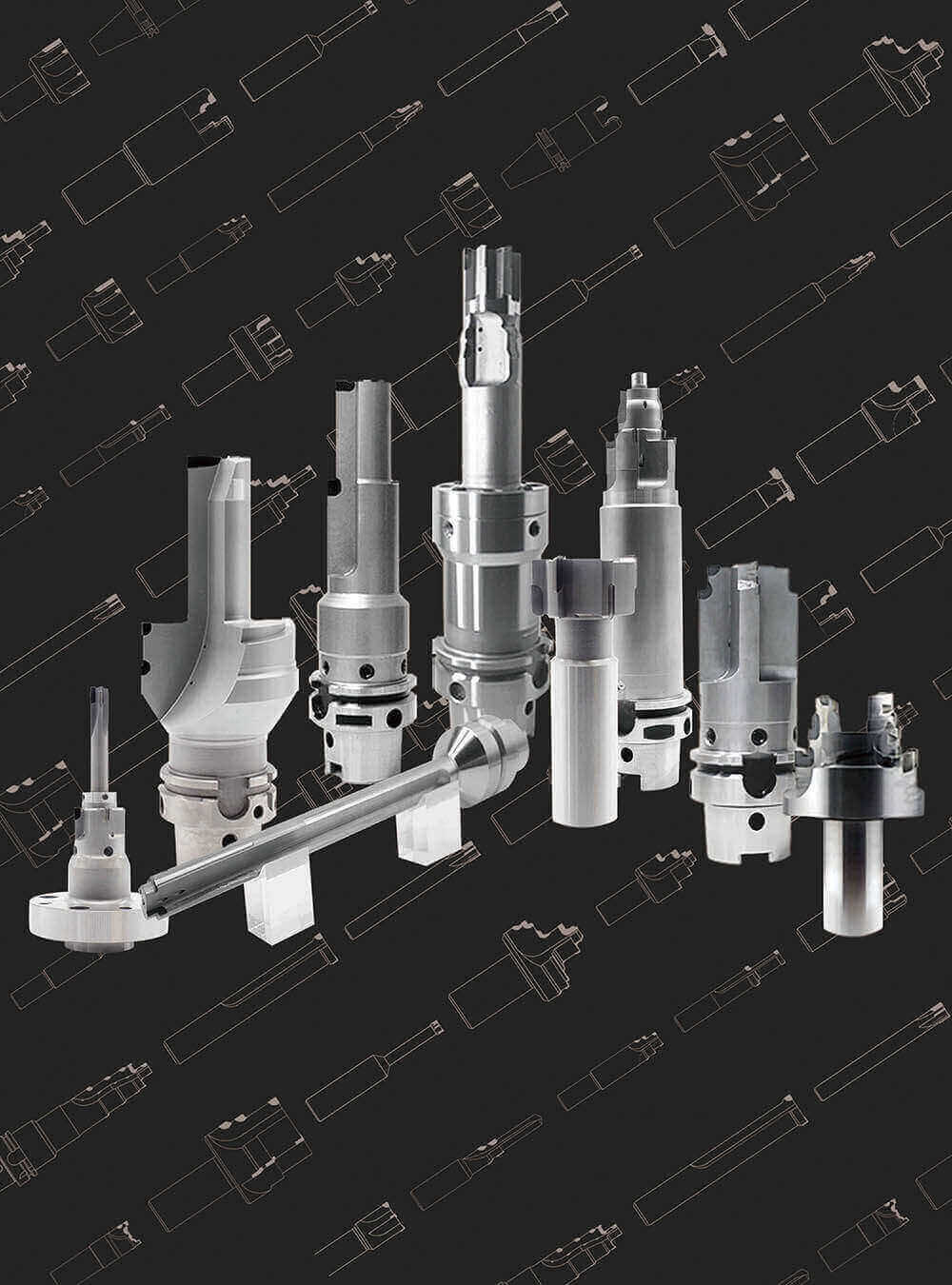Any Difference Between Ceramic Inserts and CBN Inserts for Hardened Steel
How To Choosing the Right Reamer: A Guide for Machinists
In the intricate world of metalworking and machining, precision is paramount, and the tools you use can make all the difference. Reamers often underestimated but indispensable, play a crucial role in achieving that precision. This guide unveils the importance of reamers and delves into the art of choosing the perfect one for your needs
What Is a Reamer Tool?
A reamer tool is a precision cutting instrument employed in metalworking, woodworking, and various machining applications. Its primary function is to create accurately sized and smooth holes, typically in cylindrical or conical shapes. Reamers are essential in achieving high levels of precision and quality in hole-making processes.
Key Characteristics of Reamer Tools:
- Cutting Edges: Reamers are equipped with multiple cutting edges, typically arranged in a helical or spiral pattern. These cutting edges allow for efficient material removal while maintaining precision.
- Flutes: Reamers feature flutes, which are spiral grooves that run along the length of the tool. These flutes help evacuate chips and debris from the hole being reamed, preventing clogging and ensuring a smooth finish.
- Types: There are various types of reamers, each tailored to specific applications. For example, adjustable reamers allow for fine-tuning hole dimensions, while carbide reamers offer exceptional durability for demanding tasks.
- Materials: Reamers can be made from a variety of materials, including high-speed steel, cobalt, and carbide. The choice of material depends on factors like the workpiece material, cutting speed, and the desired surface finish.

What is a Reamer Tool Used For?
A reamer tool is used for a variety of critical machining and hole-finishing tasks, primarily aimed at achieving precision and accuracy in hole creation. Here are the key applications and uses of a reamer tool:
- Hole Sizing and Finishing: Reamers are primarily employed to achieve precise and consistent hole dimensions. Whether enlarging an existing hole or creating a hole with tight tolerances, reamers are used to ensure the desired size and geometry.
- Achieving a Smooth Surface Finish: Reamer tools are known for producing exceptionally smooth and polished hole surfaces. This is crucial in applications where a high-quality, fine surface finish is required, such as in the manufacturing of precision parts and components.
- Burr Removal: Reamers can effectively eliminate burrs, irregularities, and imperfections left by previous machining processes, ensuring the final hole meets quality standards
- Correcting Misaligned Holes: In cases where a hole is not perfectly aligned or concentric, reamers can be used to correct alignment issues, making the hole concentric with the workpiece.
- Achieving Tight Tolerances: Reamers are vital when extremely tight tolerances are required in industries like aerospace and automotive manufacturing. They can achieve dimensional accuracy within very narrow specifications.
- Tool Maintenance: Reamer tools can be used for maintaining and sharpening the cutting edges of other tools, such as drills and end mills, prolonging their lifespan and ensuring consistent performance.
- Deburring and Countersinking: Reamers can serve as deburring tools to remove sharp edges or rough spots on holes. Additionally, they can be used for countersinking, creating a tapered or chamfered opening at the edge of a hole for screw or bolt heads.
- Woodworking: Reamers are also used in woodworking to create precisely sized and smooth holes for dowels, plugs, and other joinery techniques.
- Reaming in Precision Engineering: In industries where precision engineering is critical, such as medical device manufacturing, reamers are indispensable for achieving the highest levels of accuracy and quality in hole-making processes.
- Machine Maintenance and Repair: Reamers are used in maintenance and repair work to restore damaged or out-of-specification holes in machinery, ensuring the components fit properly and operate as intended.
- Aerospace Applications: In the aerospace industry, where safety and precision are paramount, reamers are used to achieve the tightest tolerances and surface finishes in critical components like aircraft engines.
- Automotive Manufacturing: Reamers are integral in automotive manufacturing for creating precise holes in engine blocks, transmission components, and other critical parts.
What are the Types of Reamers?
Reamers come in various types and designs, each tailored to specific applications and requirements. Here are the most common types of reamers:
- Hand Reamers: Hand reamers are operated manually, typically with a wrench or by turning the reamer with one’s hands. They are commonly used for smaller-scale applications and tasks where precision is essential, but the use of power tools is impractical.
- Machine Reamers: Machine reamers are designed to be used with power tools or machining equipment such as drill presses, lathes, or milling machines. These reamers are engineered to provide high-speed and consistent hole production, making them ideal for large-scale or industrial applications.
- Chucking Reamers: Chucking reamers have a straight shank and are designed to be securely held in a machine’s chuck or collet. They are versatile and can be used in various machining equipment, making them suitable for a wide range of applications.
- Tapered Reamers: Tapered reamers have a conical design, which allows them to create tapered holes. These reamers are often used for tasks such as creating holes for machine tool spindles, which require a precise taper for alignment.
- Bridge Reamers: Bridge reamers are designed for use in bridge construction and other heavy-duty applications. They have a long, straight flute design and are capable of removing significant amounts of material while maintaining precision.
- Adjustable Reamers: Adjustable reamers have replaceable blades or cutters that can be adjusted to achieve specific hole dimensions. These reamers offer flexibility and precision and are commonly used in applications where hole size requirements vary.
- Carbide Reamers: Carbide reamers are known for their exceptional hardness and wear resistance. They are ideal for machining hard and abrasive materials, such as aerospace alloys and hardened steels. Carbide reamers maintain their cutting-edge integrity even in high-temperature machining environments.
- Diamond-Tipped Reamers: Diamond-tipped reamers are used for ultra-precision tasks, particularly in industries like watchmaking and electronics. These reamers employ diamond cutting edges for superior hardness and precision.
- Shell Reamers: Shell reamers are designed for cutting larger holes. They consist of a central arbor or pilot, and multiple fluted cutters are mounted around the arbor. Shell reamers are suitable for creating large and precisely sized holes.
- Expansion Reamers: Expansion reamers are equipped with a tapered wedge that can be adjusted to expand or contract the reamer’s diameter. This flexibility allows for fine adjustments to hole size.
- Countersink Reamers: Countersink reamers are used to create a conical depression or chamfer around a hole’s entrance. They are commonly used to prepare holes for countersunk screws or bolts.
The Speeds and Feeds for Reamers?
Before delving into the specifics, it’s essential to grasp the fundamental concepts of speeds and feeds. In machining, “speed” refers to the rotational speed of the reamer, often measured in revolutions per minute (RPM). On the other hand, “feed” pertains to the rate at which the reamer advances into the workpiece material, typically expressed in inches per minute (IPM) or millimeters per minute (MMPM).
- Balancing Speed and Feed:
The relationship between cutting speed and feed rate is pivotal in achieving precision. This balance is influenced by various factors, including the type of reamer, the material being machined, and the desired finish.
Cutting Speed: The cutting speed, determined by the RPM of the reamer, dictates the rate at which the reamer’s cutting edges engage with the workpiece material. A higher cutting speed often results in a finer finish, but it’s essential to stay within the limits of the reamer and the material’s properties.
Feed Rate: The feed rate controls the depth and width of material removal during each pass. A higher feed rate means faster progress into the workpiece, but it must be adjusted to avoid overloading the reamer, which can lead to tool wear and poor surface finish.
- Selecting the Right Parameters:
Material Type: Different materials require different approaches. For example, cutting speeds for aluminum are much higher than those for stainless steel.
Reamer Type: Adjustable reamers and carbide reamers may have different optimal speeds and feed parameters due to their distinct cutting characteristics.
Tool Diameter: Larger diameter reamers generally require lower cutting speeds and feeds to prevent overheating and tool wear.
Surface Finish Requirements: The desired surface finish also influences the choice of parameters. A smoother finish often necessitates lower feed rates and higher cutting speeds.
Practical Tips for Optimizing Speeds and Feeds:
Consult Manufacturers’ Recommendations: Reamer manufacturers often provide guidelines for recommended speeds and feeds based on their products. These guidelines are an excellent starting point.
Test and Adjust: Initial setups should be tested on scrap material to ensure the desired finish is achieved. Adjustments can be made accordingly.
Monitor Tool Wear: Frequent monitoring of tool wear is essential to prevent damage to the reamer. Signs of wear may include rougher finishes or increased cutting forces.
Use Lubrication: Proper lubrication can reduce friction and heat generation, improving tool life and surface finish.
Maintain Rigidity: Ensure the workpiece, tool holder, and machine setup are rigid to prevent vibrations that can negatively affect cutting performance.
How to choosing the Right Reamer for Metal?
Coatings:
The choice of coatings can significantly impact performance. Coated reamers, such as those with TiN or TiAlN coatings, offer improved wear resistance, reduced friction, and enhanced tool life. Choose coatings that align with the material you are machining.
Consult Manufacturer Recommendations:
Reamer manufacturers often provide detailed specifications and recommendations for their products, including information on ideal applications, materials, and surface finish capabilities. Consult these recommendations to make an informed choice.
Consider Workpiece Fixturing and Stability:
The stability and rigidity of the workpiece and the machining setup are crucial. Vibrations and instability can negatively affect cutting performance and result in poor surface finish. Ensure that your workpiece and setup are robust and stable.
Test and Adjust:
Before embarking on your project, test your reamer on scrap material to ensure it achieves the desired results. Adjustments may be necessary to fine-tune the process.
Tool Maintenance:
Regularly inspect and maintain your reamers to ensure they remain sharp and in good condition. Dull or damaged reamers can lead to poor results and may need to be replaced or resharpened.
Project Specifics:
Consider the unique requirements of your project. The combination of material, hole size, and surface finish will often dictate the best reamer for the job. Tailor your choice to meet the specific demands of your project.
Material Compatibility:
Consider the specific metal you’ll be machining. Different metals have varying hardness and machinability. For example:
- Stainless Steel: When working with stainless steel, which is known for its hardness, consider using a carbide reamer, as it offers exceptional wear resistance.
- Aluminum: Aluminum is a softer material, and high-speed steel (HSS) reamers are often suitable. However, carbide reamers can also be used when high durability is required.
Hole Size and Tolerance:
Determine the required hole size and tolerance. Reamers are designed to create precise hole dimensions. Select a reamer size that aligns with the desired hole diameter, and ensure it adheres to the specified tolerances for your project.
- Surface Finish Requirements: Consider the surface finish required for your application. Reamers are renowned for producing smooth and polished hole surfaces. If a fine surface finish is crucial, opt for a reamer with the geometry and coatings that can deliver the desired finish.
- Flute Geometry and Chip Evacuation: Pay attention to flute geometry. Proper flute design is essential to ensure efficient chip evacuation, especially when working with metals that tend to produce long chips. Adjustable reamers can be useful for adapting to different chip evacuation needs.
In the realm of machining, precision, and performance are non-negotiable. This guide has equipped you with the knowledge and insights needed to select the perfect reamer for your specific machining requirements. Always remember, that the choice of a reamer can be the distinguishing factor between mediocrity and excellence in your projects. Embrace precision, and select the right reamer to elevate your metalworking projects to new heights.


